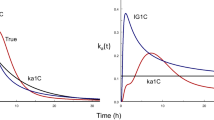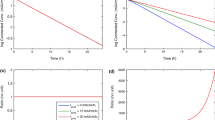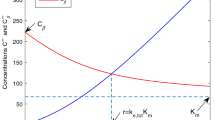Abstract
Physiological models have often been used to investigate the processes involved in drug targeting. Such a model is used to investigate some aspects of drug targeting, including the pharmacodynamics of therapeutic and toxic effects. A simple pharmacodynamic model is incorporated in a three-compartment pharmacokinetic model. Conventional administration and drug targeting are compared at steady state for the same degree of therapeutic effect. The efficiency of drug targeting is quantified as the ratio (TA) of the rates of administration of free drug or of a drug–carrier complex required to achieve this effect. Also, the ratios of drug concentrations in the toxicity compartment (DTI) or of the consequent degree of toxic effects (TI) are used to compare conventional administration with drug targeting. The kinetic characteristics of the drug–carrier complex, rate of elimination, and rate of free drug release, influence TA but not DTI or TI. The importance of these characteristics depends on the cost and toxicity of the drug–carrier complex or of the carrier alone. The pharmacodynamics of the free drug in both the target and the toxicity compartments have an important influence on TI but not on TA or DTI. As the pharmacological selectivity of the drug increases, so does TI. However, a drug with good pharmacological selectivity may not be suitable for drug targeting. TI is also very dependent on the shape of the effect–concentration curves, particularly that for toxicity. While TA increases as the rate of elimination of free drug from either central or target compartments increases, TI may actually be reduced if release of free drug is not confined to the target compartment.
Similar content being viewed by others
REFERENCES
G. Gregoriadis, G. Poste, J. Senior, and A. Trouet (eds.). Receptor-Mediated Targeting of Drugs (NATO ASI, Series A, Life Sciences, Vol. 82), Plenum Press, New York, 1984.
E. Tomlinson. Adv. Drug. Deliv. Rev. 1:87–198 (1987).
J. Robinson and V. H. L. Lee (eds.). Controlled Drug Delivery: Fundamentals and Applications, Marcel Dekker, New York, 1987.
V. J. Stella and K. J. Himmelstein. In R. T. Borchardt, A. J. Repta, and V. J. Stella (eds.), Directed Drug Delivery, Humana Press, New York, 1985, pp. 247–267.
C. A. Hunt, R. D. MacGregor, and R. A. Siegel. Pharm. Res. 3:333–344 (1986).
J. F. M. Smits and H. H. W. Thijssen. In H. A. J. Struyker-Boudier (ed.), Rate-Controlled Drug Administration and Action, CRC Press, Boca Raton, Fla., 1986, pp. 83–114.
G. Levy. Pharm. Res. 4:3–4 (1987).
R. L. Dedrick. J. Pharm. Sci. 75:1047–1052 (1986).
N. H. G. Holford and L. B. Sheiner. Pharmacol. Ther. 16:143–166 (1982).
W. W. Eckman, C. S. Patlak, and J. D. Fenstermacher. J. Pharmacokinet. Biopharm. 2:257–285 (1974).
S. Øie and J.-D. Huang, J. Pharm. Sci. 70:1344–1347 (1981).
Author information
Authors and Affiliations
Rights and permissions
About this article
Cite this article
Boddy, A., Aarons, L. & Petrak, K. Efficiency of Drug Targeting: Steady-State Considerations Using a Three-Compartment Model. Pharm Res 6, 367–372 (1989). https://doi.org/10.1023/A:1015971113161
Issue Date:
DOI: https://doi.org/10.1023/A:1015971113161




